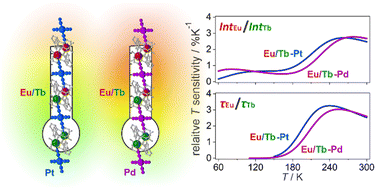Metal-cyanido molecular modulators of the sensing range and performance in lanthanide-based luminescent thermometers†
Abstract
Strategies for the rational design of lanthanide luminescent thermometers towards high temperature sensitivity as well as a wide and adjustable sensing range are required for practical applications. We present the methodology of controlling the thermometric parameters of mixed-lanthanide EuIII/TbIII coordination systems which are broadly explored as ratiometric optical thermometers due to their thermosensitive 4f–4f emissive transitions. We incorporated these lanthanide ions into coordination polymers utilizing cyanido metalloligands, namely tetracyanidometallates of PtII and PdII, as molecular bridges. We report the series of hybrid coordination polymers of the general formula of {[Ln(H2O)4(terpyO3)]2[M(CN)4]}[M(CN)4]2·8H2O (Ln2M3, Ln = Eu, Tb, Gd; M = Pt, Pd; terpyO3 = 2,2′ : 6′,2′′-terpyridine N,N′,N′′-trioxide). They exhibit red-to-green EuIII- and TbIII-centered emission sensitized by terpyO3 ligands and [MII(CN)4]2− ions, and tuned by the Eu-to-Tb metal ratio. Moreover, they show strong temperature variation of the Eu-to-Tb emission intensities ratio, the resulting emission colour, and the related emission lifetimes. The materials of the optimized Eu-to-Tb metal ratio, Eu0.6Tb1.4Pt3 and Eu0.6Tb1.4Pd3, were employed as optical thermometers utilizing the ratios between the Eu-and-Tb emission intensities and their emission lifetimes. The best thermometry performance, represented by the relative thermal sensitivity (Sr) above 1% K−1 for the broadest T-range of 181–300 K, and the highest maximal Sr of 3.26% K−1 (at 239 K), was found for the emission-lifetime-based thermometry of Eu0.6Tb1.4Pt3. The temperature ranges of good (Sr > 1% K−1) and highest accessible Sr within the whole series of materials are dependent on the applied polycyanidometallate which was correlated with the transition-metal-dependent energies of the vibrational modes of the terminal and bridging cyanido ligands as well as other components, terpyO3 and water molecules. The selected vibrations govern critical emission thermal deactivation pathways indicating that cyanido metal complexes serve as efficient molecular modulators for the characteristics and the resulting application window of lanthanide-based luminescence thermometry.



 Please wait while we load your content...
Please wait while we load your content...